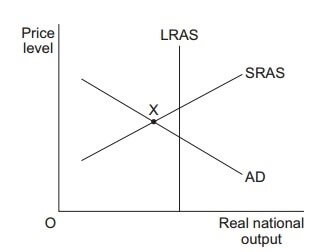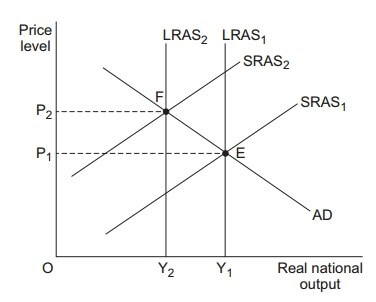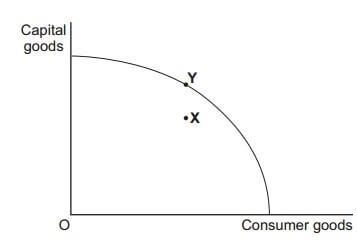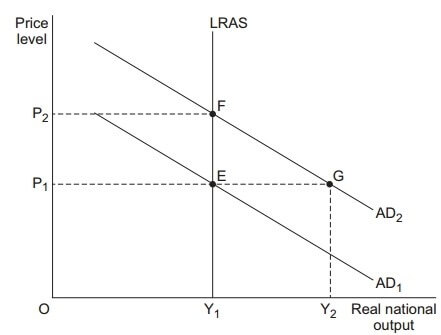AQA AS ECONOMICS: Unit 2 The National Economy SECTION A
Q.1. All other things being equal, an increase in aggregate demand would result from an increase in the
- A. deficit in the current account of the balance of payments.
- B. household saving ratio.
- C. government’s budget surplus.
- D. ratio of household consumption to national income.
Answer: D- ratio of household consumption to national income.
Q.2. Supply-side policies are aimed mainly at
- A. improving the underlying trend rate of economic growth.
- B. dealing with short-term supply-side shocks to the economy.
- C. combating cyclical unemployment.
- D. reducing the government’s budget deficit.
Answer: A- improving the underlying trend rate of economic growth
Q.3. The diagram below shows the aggregate demand (AD), the short-run aggregate supply (SRAS) and the long-run aggregate supply (LRAS) curves for an economy.

The economy is currently operating at point X. At this point, the economy must be experiencing
- A. inflation caused by excess demand.
- B. inflation caused by increasing costs.
- C. unemployment of labour.
- D. a low rate of economic growth.
Answer: C- unemployment of labour.
Q.4. Which one of the following is an example of expansionary fiscal policy?
- A. A reduction in interest rates
- B. An increase in the budget deficit
- C. An increase in the money supply
- D. A reduction in government spending
Answer: B- An increase in the budget deficit
Q.5. In which one of the following combinations of events, A, B, C or D, is the Bank of England most likely to reduce interest rates to try to boost demand?
| Money wages | Exchange rate | Consumer spending | |
|---|---|---|---|
| A | Rising | Falling | Falling |
| B | Falling | Rising | Rising |
| C | Rising | Falling | Rising |
| D | Falling | Rising | Falling |
Answer: D- Money wages are falling, Exchange rate rising and Consumer Spending falling
Q.6. Deflation in the domestic economy is most likely to
- A. cause consumers to delay their purchases of consumer durables.
- B. lead to a rise in interest rates for both borrowers and lenders.
- C. lead to a rise in both exports and imports.
- D. reduce the real value of any money that has been lent.
Answer: A- cause consumers to delay their purchases of consumer durables
Q.7. All other things being equal, which one of the following is most likely to lead to an increase in both saving and investment? An increase in
- A. the exchange rate
- B. unemployment
- C. the interest rate
- D. incomes
Answer: D- incomes
Q.8. All other things being equal, which one of the following combinations, A, B, C or D, indicates the most likely consequences for the UK of a decline in the value of the pound (£) against other major currencies?
| Exports | Unemployment | Economic Growth | |
|---|---|---|---|
| A | Increase | Decrease | Increase |
| B | Decrease | Increase | Increase |
| C | Increase | Decrease | Decrease |
| D | Decrease | Increase | Increase |
Answer: A- Exchange rate increase, unemployment rate decrease and Increase in economic growth
Q.9. Which one of the following is a correct statement?
- A. Fiscal policy can be used to affect the pattern of economic activity.
- B. The Bank of England is responsible for fiscal policy.
- C. Fiscal policy is only used to affect the demand side of the economy.
- D. The government uses fiscal policy to control the exchange rate.
Answer: A-Fiscal policy can be used to affect the pattern of economic activity
Q.10. The diagram below shows the aggregate demand (AD), the short-run aggregate supply (SRAS) and the long-run aggregate supply (LRAS) curves for an economy. The economy’s initial equilibrium is at point E.

Which one of the following developments affecting the economy, A, B, C or D, is most likely to account for the movement of macroeconomic equilibrium from E to F?
- A. An increase in labour productivity and wage rates
- B. A decrease in the underlying trend rate of growth and a decrease in world commodity prices
- C. A decrease in government expenditure and an increase in indirect taxation
- D. A fall in productivity and an increase in world commodity prices
Answer: A- An increase in labour productivity and wage rates
Q.11. In which one of the following situations is a government most likely to pursue an expansionary fiscal policy?
- A. When there is a positive output gap
- B. When the long-run trend rate of economic growth is too low
- C. When there is a high level of structural unemployment
- D. When cyclical unemployment is increasing
Answer: B- When the long-run trend rate of economic growth is too low
Q.12. The table below shows changes in macroeconomic indicators for an economy. During a time of rising unemployment, labour productivity has increased whilst at the same time income per head has fallen.
All other things being equal, which combination, A, B, C or D, is most likely to result from these changes?
| The rate of inflation | The balance of payments deficit on current account | |
|---|---|---|
| A | Increases | Decreases |
| B | Decreases | Increases |
| C | Increases | Increases |
| D | Decreases | Decreases |
Answer: D- Rate of inflation- decreases and the balance of payments deficit on current account- decreases
Q.13. The UK economy is most likely to be in the boom phase of the economic cycle when there is a rise in
- A. the demand for imports.
- B. the saving ratio.
- C. spare capacity.
- D. business pessimism.
Answer: A- the demand for imports
Q.14. Which one of the following best illustrates the accelerator process?
- A. A change in one of the components of aggregate demand leading to a much greater increase in national income
- B. An increase in national income resulting in a proportionately larger rise in investment
- Government subsidies to firms for research and development helping to increase the rate of innovation
- An increase in government spending during a recession helping to stimulate investment
Answer: B-An increase in national income resulting in a proportionately larger rise in investment
Q.15. The diagram below shows an economy operating on its production possibility frontier at point Y.

All other things being equal, which one of the following is most likely to move the economy from point Y to point X within its production possibility frontier?
A decrease in
- A. inflation
- B. investment expenditure
- C. productive capacity
- D. the trend rate of growth
Answer: C- productive capacity
Q.16. If the world economy goes into recession, this is likely to increase unemployment in the UK because the
- A. ability of other economies to supply UK industry with basic commodities will be reduced.
- B. value of goods and services exported from the UK will fall.
- C. price of oil and other raw materials is likely to rise.
- D. value of the pound will fall on the foreign exchange market.
Answer: B- value of goods and services exported from the UK will fall.
Q.17. A country has seen the following changes to two macroeconomic indicators over the period 2012 to 2015.
| Year | CPI inflation (%) | Average earnings growth (%) at current prices |
|---|---|---|
| 2012 | 2.5 | 3.0 |
| 2013 | 2.4 | 2.7 |
| 2014 | 0.6 | 0.2 |
| 2015 | 0.5 | 0.8 |
Which one of the following can be concluded from the data?
- A. The nominal value of earnings was lower in 2015 than in 2012
- B. Prices and average earnings were higher in 2015 than in 2012
- C. The real value of average earnings declined each year
- D. Prices fell between 2012 and 2015
Answer: B- Prices and average earnings were higher in 2015 than in 2012
Q.18. The table below shows possible causes of shifts in the aggregate demand (AD), the short-run aggregate supply (SRAS) and the long-run aggregate supply (LRAS) curves for an economy. All other things being equal, which one of the following combinations, A, B, C or D, is correct?
| AD shifts to the right | SRAS shifts to the left | LRAS shifts to the right | |
|---|---|---|---|
| A | Spending on imports increases | Factory rents increases | Investment increases |
| B | The budget surplus increases | Wages rise | Productivity increases |
| C | The current account deficit on the balance of payments decreases | The cost of imports rises | The size of the working population increases |
| D | Consumer confidence improves | Value added tax (VAT) increases | Wages fall |
Answer: D- Consumer confidence improves, Value Added Tax (VAT) increases and Wages fall
Q.19. Which one of the following combinations of policy instruments involves only the use of monetary policy measures?
- A. Lower taxes and more government spending
- B. Lower interest rates and a budget deficit
- C. A reduction in the exchange rate and a cut in the tax on firms’ profits
- D. Lower interest rates and a reduction in the exchange rate
Answer: D- Lower interest rates and a reduction in the exchange rate
Q.20. All other things being equal, an economy is most likely to experience demand-pull inflationary pressure when it has
- A. a high rate of productivity growth.
- B. a positive output gap.
- C. an increase in the value of its exchange rate.
- D. an increase in the rate of interest.
Answer: B- a positive output gap.
Q.21. The table below shows the components of an economy’s current account balance in 2015.
| £bn | |
|---|---|
| Export of goods | 500 |
| Export of services | 400 |
| Import of goods | 800 |
| Import of services | 800 |
| Net investment income | +50 |
| Net transfers | +100 |
It follows that the balance on current account for 2015 is
- A. + £2150bn
- B. + £200bn
- C. – £200bn
- D. – £50bn
Answer: D: – £50bn
Q.22. The diagram below shows the aggregate demand (AD) and the long-run aggregate supply (LRAS) curves for an economy. The economy is in equilibrium at point E.

The government predicts that aggregate demand will increase in the long run from AD1 to AD2. All other things being equal, which one of the following policies is most likely to move the economy to a new long-run equilibrium at point G rather than point F?
- A. Pursuing an expansionary monetary policy
- B. Allowing the exchange rate to rise
- C. Increasing taxation
- D. Improving the flexibility of the labour market
Answer: D- Improving the flexibility of the labor market
Q.23. The growth of an economy is below its trend rate and it is simultaneously experiencing inflation and a deficit on its balance of trade. All other things being equal, a reduction in the rate of income tax is most likely to lead to a decrease in the
- A. inflation rate.
- B. level of unemployment.
- C. rate of economic growth.
- D. balance of trade deficit.
Answer: B- level of unemployment
Q.24. The table below shows the growth rates (% change over previous period), of an economy’s real GDP per capita between 2011 and 2015.
| 2011 | 2012 | 2013 | 2014 | 2015 |
|---|---|---|---|---|
| 2.9 | -1.6 | -4.6 | -1.0 | 0.1 |
From the data in the table it can be inferred that the
- A. average amount produced per person was lower in 2015 than in 2011.
- B. the rate of growth of nominal GDP must also have been positive in 2015.
- C. rate of inflation declined after 2013.
- D. rate of population growth varied between 2011 and 2015.
Answer: A- average amount produced per person was lower in 2015 than in 2011.
Q.25. A negative output gap necessarily means that the economy
- A. is in recession.
- B. is suffering from demand-pull inflation.
- C. is operating inside its production possibility frontier.
- D. has a productive potential below its current level of Gross Domestic Product.
Answer: A-is in recession.
AQA AS Economics Questions With Answers
- AQA AS Economics Unit 1 Section A
- AQA AS Economics Unit 1 Section B Part 1
- AQA AS Economics Unit 1 Section B Part 2
- AQA AS Economics Unit 2 Section A
- AQA AS Economics Unit 2 Section B part 1
- AQA AS Economics Unit 2 Section B part 2
- AQA AS Economics 2015 Unit 1 Section A
- AQA AS Economics 2015 Unit 1 Section B Part 1
- AQA AS Economics 2015 Unit 1 Section B Part 2
- AQA AS Economics 2015 GCSE solved Question Paper


